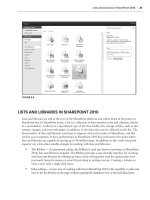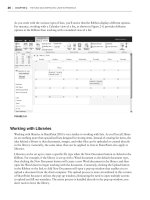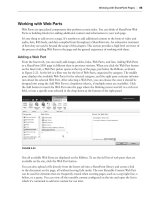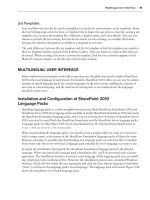Thủ thuật Sharepoint 2010 part 79 doc
Bạn đang xem bản rút gọn của tài liệu. Xem và tải ngay bản đầy đủ của tài liệu tại đây (1.42 MB, 17 trang )
PerformancePoint Services
and Business Intelligence
WHAT’S IN THIS CHAPTER?
Installing and confi guring PerformancePoint Services
Dashboard Designer
Importing PerformancePoint Server 2007 content to
PerformancePoint Services 2010
PerformancePoint Services (PPS) is one of the built-in services in SharePoint Server 2010. PPS
is a performance management application that individuals use to monitor and analyze business
data to help improve effectiveness and effi ciency. Microsoft’s Business Intelligence (BI) solution
is based on using PPS in SharePoint 2010, SQL Server, and the Offi ce Platform. PPS is avail-
able to any company that installs SharePoint Server 2010 using an Enterprise key, and has
purchased Enterprise Client Access Licenses (CALs) for its employees.
Microsoft introduced PerformancePoint capability in a stand-alone product called PerformancePoint
Server 2007 (PPS2007), and this capability integrated with SharePoint Server 2007 through
the use of Web Parts. With the introduction of SharePoint Server 2010, PPS is now an integrated
part of SharePoint 2010’s architecture and exists as one of the available services. PPS retains
many of the same features and functionality as its predecessor while including additional ben-
efi ts, enhancements, and new functionality. PPS provides the capability to create and utilize
BI objects referred to as dashboards, scorecards, and key performance indicators (KPIs). PPS
also provides the capability to upgrade PPS2007 content using a wizard-driven process.
Using PPS begins with creating objects using a rich client tool called Dashboard Designer.
Dashboard Designer provides a What-You-See-Is-What-You-Get authoring experience.
20
586
CHAPTER 20 PerformaNcePoiNt services aNd BUsiNess iNtelligeNce
Designer objects are stored in SharePoint lists and libraries so that they can be utilized by other
SharePoint 2010 features. Once these objects have been created, they are published or deployed
to SharePoint 2010 websites so that their information can be viewed by individuals across the
enterprise.
To do justice to the PerformancePoint capability in SharePoint Server 2010, we would need to write
a whole book just to introduce the numerous features. The good news is that you will find books
dedicated to PPS if you are interested, as well as books that are dedicated to specific elements of PPS.
Yes, it is both deep and wide. Our purpose in this chapter is to provide the administrator with the
information necessary to install and configure PPS, while briefly introducing the BI capability and
features. We start with a very brief introduction of key PPS features and terminology.
PPS FEATURES AND TERMINOLOGY
This section introduces the PerformancePoint Services capabilities, and provides a table summarizing
the relevant terminology that is used in Microsoft BI and in this chapter.
PerformancePoint is one of the services in SharePoint Server 2010. The administrator will
utilize the new service application architecture to install and configure PPS.
PPS is used to create, display, and interact with first-class objects (FCOs). FCOs are dash-
boards that contain scorecards, reports, KPIs, filters, and data sources. FCOs bring data
together from multiple data sources. Table 20-1 provides descriptions of the FCOs.
FCOs are stored as content types and secured within SharePoint Server 2010 lists and librar-
ies, providing a single repository for the information. Specifically, data sources are stored in
document libraries, and all other FCOs are stored in lists. Dashboards that are stored in the
list as FCOs represent dashboard pages, while dashboards that have been deployed are stored
in a different document library. Under the covers, an FCO is defined by XML data in the
content type.
Because PPS is now built into SharePoint Server 2010, it can take advantage of the other
SharePoint Server 2010 features, such as the security framework, scalability, collaboration,
backup and restore, search, and disaster recovery capabilities.
PPS Web Parts can link to other PPS Web Parts or other SharePoint 2010 Web Parts on the
same page.
PPS includes a new type of report called the
Decomposition Tree. The Decomposition Tree
simplifies the display of a multi-dimensional data set so that the data can be more readily
interpreted. Because easy visualization and interpretation is at the heart of the BI process, this
is going to be a very popular view.
Before we introduce Dashboard Designer and demonstrate how BI objects are created and published,
we need to describe how to install and configure PPS. This is a key aspect for the administrator, so it
represents the bulk of the chapter.
PPS Installation and Configuration
587
TABLE 201: First-Class Object Terminology
OBJECT DESCRIPTION
Dashboard A visual display of information that helps promote collaboration and improve
decision making. This display includes scorecards, KPIs, reports, and filters. A
dashboard is created using Dashboard Designer and published to SharePoint
Server 2010.
Scorecard One or more elements of a dashboard that represent a compilation of KPIs.
They are used to track status, and they help measure KPIs.
Key Performance
Indicator (KPI)
Measures the performance or success against some metric defined by the
organization. This usually involves comparing a target value to an actually
achieved value. For example, you could compare target sales by geography to
actual sales by geography.
Filter Controls the view of a dashboard so that only select items are available.
Indicator A visual element of a KPI that quickly displays the status without drilling into the
data. The iconic example is the red, yellow, and green colors of the trac light.
Data Source Provides the information for PPS to connect to a back-end system that con-
tains information. PPS can connect to Analysis Services, Excel Services, Excel
Workbooks, SharePoint Lists, and SQL Server Table and Views.
Reports Allows data to be visualized and summarized using charts. PPS includes several
types of reports: Analytic Chart, Analytic Grid, Strategy Map, KPI Details, SQL
Server Reporting Services reports, and Excel Services.
PPS INSTALLATION AND CONFIGURATION
The installation and configuration of SharePoint 2010 was presented in depth in Chapter 4, so only
the pertinent details for installing and configuring PerformancePoint Services are discussed in this
chapter. You should review Chapter 4 to ensure you have a good understanding of the SharePoint
2010 installation and the wizards that are available to assist in the configuration, but some of the
relevant details are repeated here for simplicity.
After SharePoint 2010 is installed, the administrator must configure the SharePoint farm. There are
two wizards: the SharePoint Products and Technologies Configuration Wizard, which is used to create
a new SharePoint farm or add your server to an existing farm, and the Farm Configuration Wizard (or
Central Administration Wizard), which is used to help you provision service applications. Our inter-
est is in the second wizard. Both of these wizards were run as part of the installation instructions in
Chapter 4; but you should know that the Farm Configuration Wizard can be launched from the
Central Administration home page using the Configuration Wizards link and the Launch the Farm
Configuration Wizard link on the Configuration Wizards web page. This should display the web
page shown in Figure 20-1.
588
CHAPTER 20 PerformaNcePoiNt services aNd BUsiNess iNtelligeNce
FIGURE 201
At this point, you have two options. The first option activates the wizard discussed in Chapter 4,
whereas the second option returns you to the Central Administration default page. If you don’t use
the wizard, you will have to manually create the default web application, the default site collection,
and activate any service applications that are necessary to support the PerformancePoint capability.
Because the wizard has likely already been run, it is possible that the necessary services are already
available and PerformancePoint is ready to be used. However, SharePoint administrators should
know how to enable and configure the PerformancePoint capability regardless of the state of the
server farm, so we will discuss the manual configuration approach here in order to ensure that you
have a thorough understanding of the details.
PerformancePoint Service Application and Proxy
The first step in configuring PPS is to ensure that the PPS service application and proxy have been
created, along with the corresponding applications for the Secure Store Service. The following steps
take you through this process.
1. Ensure that the PerformancePoint Service and the Secure Store Service have been started.
These services need to be running on the application servers to support PerformancePoint
capability.
Browse to the Services on Server web page in Central Administration (see Figure 20-2). You
should see a list of the different services and their status.
Scroll down the page until you can see the two services and verify that they are both in
the Started state. If not, click the Start link directly to the right of the Stopped value in the
Status column and start the service.
The PerformancePoint service application calls instances of these services to process
requests. As you can see, these service instances can be started on a per-instance basis.
Therefore, administrators only need to start the services that will be used, which is one of
the key advantages of the SharePoint 2010 service architecture. Contrast this to SharePoint
PPS Installation and Confi guration
589
2007, where the shared service provider included a fi xed set of services that were all running
all of the time, regardless of which was actually needed.
FIGURE 202
2. The next step is to ensure that a PerformancePoint service application has been created and is
running.
Creating the service application creates the service application proxy that facilitates web ser-
vice calls between the WFE and the application server using the Windows Communication
Framework. This is accomplished by confi rming that the PerformancePoint Service
Application is running. To do so, browse to the Manage Service Applications web page.
If the service application does not exist, click the New button in the Ribbon and choose
PerformancePoint Service Application from the list of options, shown in Figure 20-3.
The set of service applications can also be obtained using the PowerShell cmdlet
Get-SPServiceApplication.
A unique name and an application pool are required for confi guring a new service applica-
tion, as shown in Figure 20-4. The name is the display name of the service, and differs from
the service application’s identity, which is a GUID that is automatically assigned when the
application is created. The identity is used to distinguish the service application from any
other service application, as two different applications cannot have the same GUID. The
identity can be viewed using PowerShell, with the
Get-SPServiceApplication cmdlet.
590
CHAPTER 20 PerformaNcePoiNt services aNd BUsiNess iNtelligeNce
FIGURE 203
FIGURE 204
PPS Installation and Configuration
591
As part of creating a new service application, you have the option to specify whether this
service application instance should be available by default for use by web applications in
the farm. Checking this option adds the instance to the farm’s list of default service applica-
tions. However, even though a service application proxy exists within the default group, it
does not automatically make it the default application proxy within the default group.
Let’s see what it means to enable this option. A default application proxy is used by all ser-
vice applications in a given web application to communicate with that service application’s
web service. For a proxy to be the default of the default group, it must be designated as such
on the Service Application Associations page. The Service Application Associations web
page displays the relationships between the web applications in the farm, the Application
Proxy Group, and the Application Proxies, as shown in Figure 20-5.
FIGURE 205
Only one proxy group can be associated with a web application. Within that proxy group,
you can enable as many proxies as necessary. If you disable proxies, the associated service
applications won’t be available for use within the web applications associated with that
proxy group. As shown in Figure 20-5, two different PerformancePoint service applications
exist: the PerformancePoint Service Application created by the wizard during the install
and the Test PPS service application that the author created manually for illustration.
By clicking on the default proxy group link, you will see (as shown in Figure 20-6) that
Test PPS is not the default of the default group. You can change the default association
by clicking the [set as default] link.
Now that you better understand what enabling this option means, you can complete
creating the service application by defining an application pool. You can use an exist-
ing application pool or a new application pool. A new application pool requires the use
of the Configurable option because the Predefined option is not available for creating
PerformancePoint dashboards, and the recommendation is to use a domain account.
After the Name and Application Pool sections are complete, finish the process by click-
ing the Create button. After the service application and proxy have been created, the
592
CHAPTER 20 PerformaNcePoiNt services aNd BUsiNess iNtelligeNce
New PerformancePoint Service Application dialog is displayed, as shown in Figure 20-7.
You should review this dialog, especially the additional steps required to complete the
configuration.
FIGURE 206
FIGURE 207
3. PerformancePoint Services service applications utilize a SQL Server database for storing infor-
mation. This database is created when the service application is created and can be viewed by
opening SQL Server Management Studio. As shown in Figure 20-8, the two PerformancePoint
PPS Installation and Configuration
593
service applications that have been created are displayed here: PerformancePoint Service
Application and Test PPS. As you can see, there are several different databases, each asso-
ciated with different service applications. These databases are created automatically and
usually append a GUID to the end of the database name to help ensure a unique database
name. By default, all new PerformancePoint service application databases are installed on
the same server as the configuration database. The data displayed in PerformancePoint
dashboards can be stored in any SQL Server instance, assuming that the proper security
context has been set up for the users who view and create those dashboards.
FIGURE 208
4. Browse to the PerformancePoint Service Application web page by clicking the service applica-
tion link on the Manage Service Applications web page. As shown in Figure 20-9, there are
four different categories of options that further specify the PerformancePoint configuration.
We will return to these later in this chapter.
FIGURE 209
594
CHAPTER 20 PerformaNcePoiNt services aNd BUsiNess iNtelligeNce
Secure Store Service Application and Proxy
The Secure Store Service is a new capability in SharePoint 2010 that replaces the single sign-on
(SSO) capability present in SharePoint 2007. SharePoint 2010 stores the credentials for accessing the
external data in the database associated with the service application.
PerformancePoint Services requires the use of the Secure Store Service to connect to external data
sources on behalf of users or groups using the unattended service account. The unattended account
utilizes a domain account whose password is stored in the secure store. The secure store is configured
by providing a passphrase, and the passphrase is used to generate a key that is used to encrypt and
decrypt the credentials stored in the Secure Store Service database.
The following list details a few key aspects of the Secure Store Service.
The service provides the capability to store and retrieve access credentials to external systems.
These credentials consist of a user identity and password that are mapped to an application
ID. The Secure Store Service supports both individual mappings and group mappings.
Application IDs are used to map individual users or groups of users to credential sets.
Individual users are mapped to a unique set of credentials, while individuals in a group will
all receive the mapping designated for the specific domain group.
SharePoint 2010 or custom applications access the external data using the application ID on
behalf of the user or group.
Security governs each application ID, so each ID can have permissions applied that specify
which users or groups can access the credentials stored for the application ID.
The Secure Store Service runs on the application server, and it is a claims-aware authorization
service. (For a review of claims-based authentication, read Chapter 9.)
In our example, the wizard created a Secure Store Application instance, and the Chapter 4 instal-
lation instructions configured the instance by supplying the passphrase. If the store had not been
set up, you would have seen a warning on the PerformancePoint Service Application Settings page
indicating that a secure store hasn’t been configured. Therefore, we will proceed assuming a store
doesn’t exist, and the first step is to ensure that a Secure Store Application instance and proxy have
been created.
1. Create a new Secure Store Service application and proxy called Test Secure Store using the
same process used previously to create a new PerformancePoint Service application—clicking
the New button in the Ribbon on the Manage Service Applications web page. The resulting
Secure Store Service Application: Test Secure Store page is shown in Figure 20-10. As indicated
in the figure, you must first generate a new key before you can use the store.
PPS Installation and Configuration
595
FIGURE 2010
2. Click the Generate New Key button located in the Key Management Group to reveal the
Generate New Key dialog shown in Figure 20-11.
FIGURE 2011
3. Type a passphrase string inside the Pass Phrase box and retype the same string in the Confirm
Pass Phrase box. Keep in mind that the passphrase string is not stored, so ensure that it is
596
CHAPTER 20 PerformaNcePoiNt services aNd BUsiNess iNtelligeNce
written down and stored in a safe place. Administrators will need the passphrase string to
refresh the key, which is necessary whenever a new application server is added to the farm
or during a restore of a previously backed up Secure Store Service database. The string must
be at least eight characters and must have at least three of the following four elements:
Uppercase characters
Lowercase characters
Numerals
Any of the following special characters: “! " # $ % & ' ( ) * + , - . / : ; < = > ? @ [ \ ]
^ _ ` { | } ~
4. Click the OK button to complete the process.
5. Now you need to configure the unattended service account. From the Manage Service
Applications web page, click the PerformancePoint Service Application, and then click the
Manage button. Click the PerformancePoint Service Application Settings link, and enter a
username and password in the respective boxes in the Secure Store and Unattended Service
Account section. This information is used for authenticating and querying data sources.
6. Click the OK button when finished, leaving all other sections and their values at their
defaults. If everything worked correctly, when you return to the settings page you will see the
Secure Store Service name and the user representing the unattended service account, as shown
in Figure 20-12.
FIGURE 2012
7. Browse to the Secure Store Service settings page. You should see that the PerformancePoint
Service Application has been added as a target application of the secure store, and an appli-
cation ID has been generated, as shown in Figure 20-13. PerformancePoint will always try
to use the Secure Store Service in the default proxy group, even if you have multiple Secure
Store Service instances.
PPS Installation and Configuration
597
FIGURE 2013
You can now install PerformancePoint Services using the wizard as described in Chapter 4, and
manually using the process described in this chapter. Each approach has its advantages, but a good
administrator needs to know both. The wizard enables administrators to create new service appli-
cations for each service in the farm and assign a single application pool account to run all of the
service applications, and those service applications will use the default proxy group to connect to
the application server.
The wizard should not be used when you need to install and run different service applications on
different application servers. Also, you still have to configure the secure store and define an unat-
tended service account even if the wizard was used.
The final step in the installation and configuration is validating that everything was done correctly.
We will create a new website and install the new Dashboard Designer so you can see that all is
working as planned.
Installing the Business Intelligence Center Website
The Business Intelligence Center Web site is created using a new BI template. Dashboard Designer is
installed once the new BI site has been created. These steps are discussed below.
1. Create a new web application if you have not already done so. Use the instructions in
Chapter 4 if you need assistance. As you proceed through the configuration, you have two
options: Classic Mode Authentication (NTLM) or Claims-Based Authentication, as shown
in Figure 20-14. Claims-based authentication is discussed in detail in Chapter 9. You should
be aware of this new capability, but in this example we will use Classic Mode, which uses
Windows authentication to validate users.
598
CHAPTER 20 PerformaNcePoiNt services aNd BUsiNess iNtelligeNce
FIGURE 2014
2. Create a new site collection (refer to Chapter 4 for instructions if needed). Use the Business
Intelligence Center template on the Enterprise tab to provision the site collection, as this
is the standard template for PerformancePoint objects. This template contains all of the
necessary SharePoint content types used to create BI dashboards. You can certainly add
PerformancePoint content types to standard Web Part pages, lists, and libraries in order
to create deployment targets, but it’s much easier to use the Business Intelligence Center
template.
If the Business Intelligence Center template isn’t visible, then you probably
installed SharePoint 2010 server using a Standard license key. PerformancePoint
Services requires an Enterprise license key.
3. Browse to the business intelligence site collection created in step 2 and you should see the
Business Intelligence Center, shown in Figure 20-15. Mouse over each of the descriptions on
the right—Monitor Key Performance, Build and Share Reports, and Create Dashboards—to
review the different capabilities that are available.
PPS Installation and Configuration
599
FIGURE 2015
4. You should also be aware of the features that have been activated by provisioning the site
using the Business Intelligence Center template. Figure 20-16 shows a portion of the site
collection Features web page. Note that the Publishing and PerformancePoint features are
enabled.
FIGURE 2016
The final steps in validating the installation is to install and use the PerformancePoint Dashboard
Designer to create a data source, a scorecard, and a dashboard. The next section describes how to
install the Dashboard Designer 2010 application. Actual creation of PerformancePoint objects is
done in the section “Creating an Analytic Chart Report and Dashboard.”
600
CHAPTER 20 PerformaNcePoiNt services aNd BUsiNess iNtelligeNce
Installing PerformancePoint Dashboard Designer
PerformancePoint Dashboard Designer 2010 is the tool used to create and deploy your business
intelligence objects to the SharePoint 2010 server. Specifically, these include key performance indica-
tors (KPIs), scorecards, reports, filters, data sources, and dashboards. Once these objects have been
created, they are stored in one or more SharePoint 2010 document libraries and lists so that they can
be reused in different dashboards.
Dashboard Designer is a desktop application that must be deployed to an author’s desktop before it
is available for use. It requires several prerequisites on the author’s desktop:
Dashboard Designer is a .NET Framework ClickOnce application that requires the .NET
Framework 3.5 SP1 or later. If this is not installed on the client machine, Dashboard
Designer will not install.
Visio 2007 or 2010 Professional for creating or editing strategy map reports. Strategy maps
are reports that enable you to connect KPI data to Visio shapes in order to visualize data.
Report Viewer 2008 for creating or editing SQL Server Reporting Services reports.
It’s time to install the designer tool. Follow these steps:
1. From the home page of the Business Intelligence Center, hover over the Create Dashboards
heading to reveal the view shown in Figure 20-17. Click the Start using PerformancePoint
Services link contained in the Add Insight to Information With Dashboards section.
FIGURE 2017
Introduction to Dashboard Designer
601
2.
This should reveal the web page shown in Figure 20-18. From this page, click the Run Dashboard
Designer button to initiate the ClickOnce deployment process. Dashboard Designer 2010 is
automatically deployed to the client desktop using ClickOnce technology. After a few checks,
the designer is downloaded and installed to the client’s desktop and opened to the design pane.
Installation is quick, without any need for installation media or files. The application is hosted
on the SharePoint 2010 server, so software patches are applied automatically the next time the
designer is launched, assuming any software updates have been applied to the SharePoint 2010
server. This is all handled by the ClickOnce technology.
FIGURE 2018
After Dashboard Designer has been downloaded and installed on the client desktop, it can be launched
from the desktop using the PerformancePoint Dashboard Designer shortcut in the SharePoint folder on
the Start menu. It can also be launched from the SharePoint list that contains the PerformancePoint
Designer objects. At the time of this writing, Dashboard Designer does not operate in offline mode,
so the author must be connected to the SharePoint 2010 server to edit and create designer objects.
INTRODUCTION TO DASHBOARD DESIGNER
The visual elements of Dashboard Designer are displayed in Figure 20-19. Across the top of the
designer display is a ribbon with three tabs: Home, Edit, and Create. There is a Workspace Browser
pane on the left-hand side of the designer, and a centrally located pane that contains two tabs. A
SharePoint tab displays a view of the items that have been deployed to the SharePoint server, and a
Workspace tab (shown in Figure 20-19) displays a view of the items in the local workspace. A third
pane, Details, is not shown, but will appear at different points in the process of creating objects, as
you will see in the following example.









